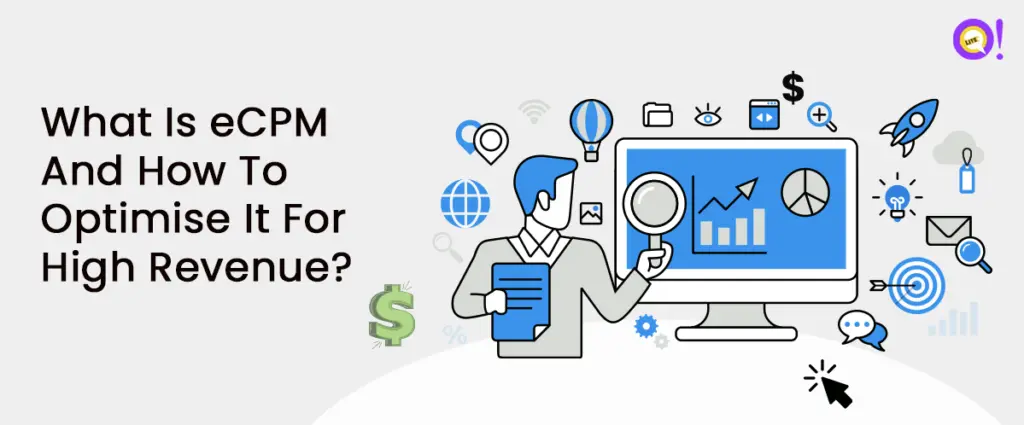
There are many advertising strategies to generate revenue from websites or apps. However, if you’re not monitoring the right indicators, it can be challenging to understand which strategies are working effectively and which are not delivering results. Among the various important metrics, one that needs to be evaluated is eCPM. Whether you’re a digital marketer, advertiser, or publisher, understanding eCPM is essential for evaluating the effectiveness of your advertising efforts and identifying opportunities to increase revenue.
In this blog, we’ll explore eCPM, its differences from CPM, and, most importantly, how to increase eCPM.
What is eCPM?
The abbreviation eCPM stands for “effective cost per mille.” It’s a key metric in measuring ad performance, indicating the total revenue earned from ads per 1,000 impressions. Therefore, the higher your eCPM, the more revenue you earn from your ad units. It’s an advertiser’s side metric that helps them decide the budget of their campaigns.
eCPM vs. CPM
Generally, people confuse these terms and often use eCPM and CPM interchangeably.
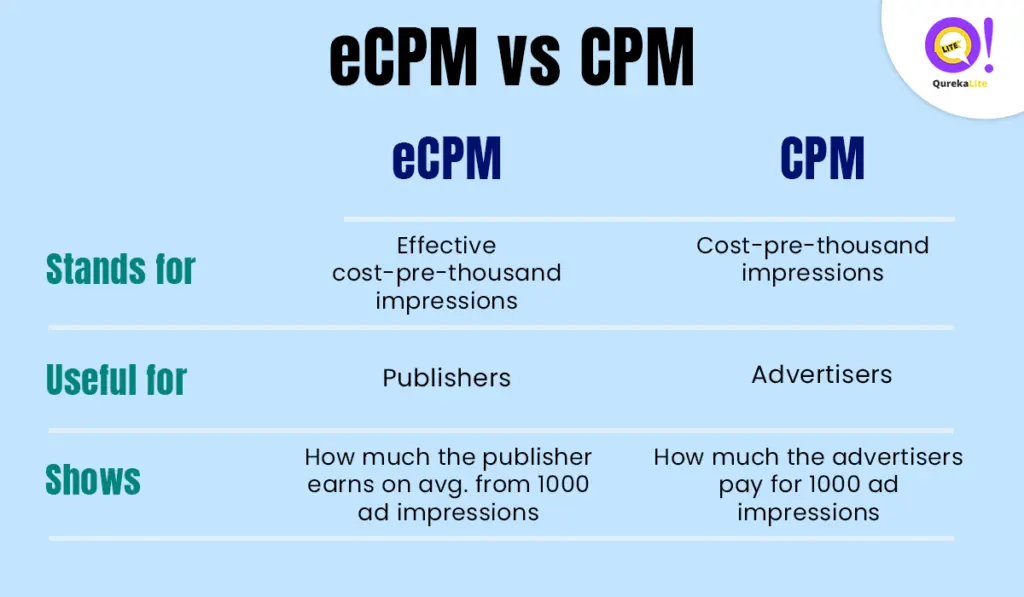
CPM, or cost per mille, or cost per thousand impressions, is the amount advertisers are willing to pay for every one thousand impressions they receive. It’s an advertiser’s side metric that helps them decide the budget of their campaigns. While eCPM is used by publishers to forecast earnings per 1,000 impressions.
Also Read: Why HTML5 is considered as the future of online gaming
How do I calculate eCPM?
eCPM can be calculated by using the following formula:
eCPM = (Total Earnings ÷ Total Impressions) x 1,000
Where,
Total Earnings = The total ad revenue generated by displaying ads on a website or an app. These can include revenue generated from CPM, CPC, CPA, and other ad pricing models.
Total Impressions = The total number of times the ad has been displayed on the website or app.
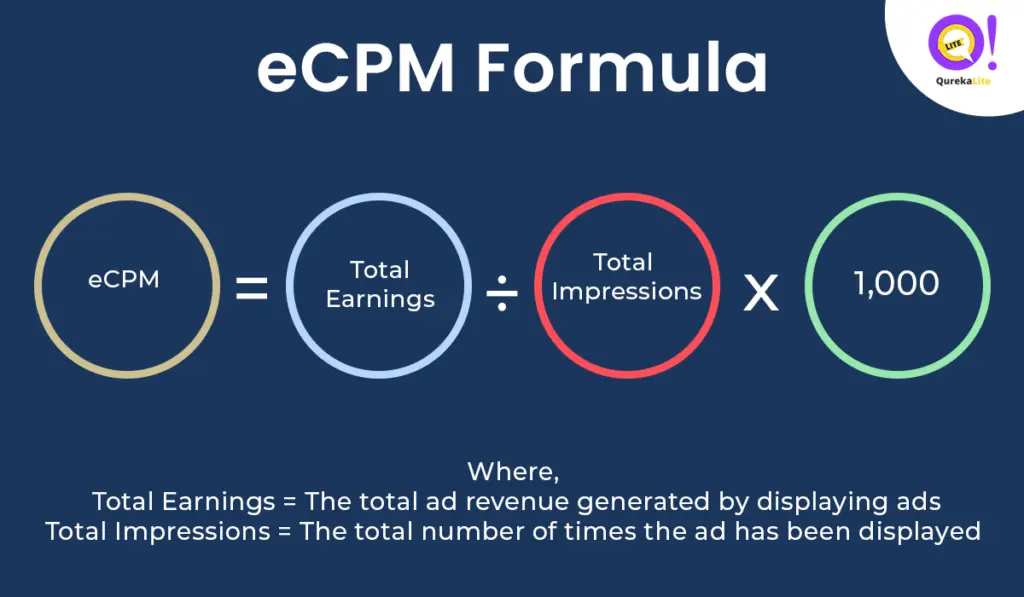
If your one particular ad unit has 40,000 impressions on your website and generates $150, then we can easily calculate eCPM with the above-mentioned formula.
eCPM = ($150/40,000) x 1,000
eCPM= $3.75
By calculating eCPM for different ad units, we can gain insights about performance and determine which ones are working more effectively for us.
Why is eCPM important for publishers?
By evaluating eCPM, you can compare the performance of different ad units, pricing models, and ad networks. These insights empower you to optimize your strategies, leading to better results and increased revenue.
With eCPM calculated for each ad unit, you get insights about the effectiveness of:
- Ad placement: Determine whether placing ads above or below the fold yields higher eCPM. Enhancing visibility can boost eCPM.
- Ad format (banner, video, native, etc.): Assess which formats generate the highest eCPM.
- Quality of ad: Evaluate the impact of ad quality on eCPM and refine accordingly.
- Ad networks: Identify which ad networks deliver the highest eCPM for your ad units.
- Targeting: Assess whether your ad targeting effectively engages viewers and influences eCPM.
Also Read: How Offerwall Ads Enhance User Retention And Monetization In 2024
How to increase eCPM?
Increasing eCPM is a primary goal for publishers, as it directly correlates with higher earnings. Here are some effective strategies to boost eCPM:
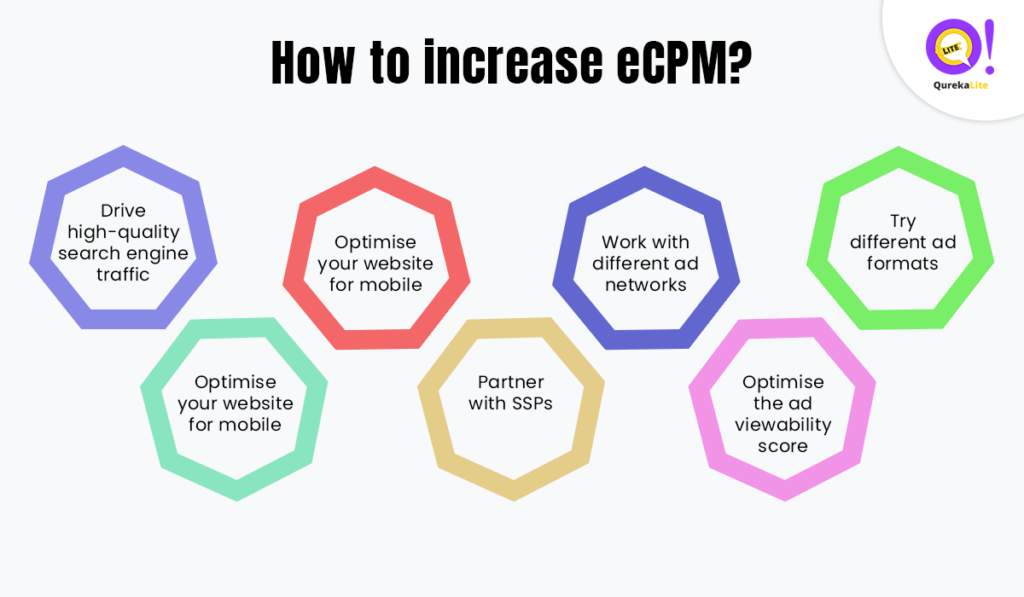
Drive high-quality search engine traffic
Quality and the source of your website traffic impact your eCPM. Search engine traffic, particularly from organic search results, typically generates a high eCPM. This is because users arriving via search engines are already looking for some relevant information, leading to higher engagement with your content and ads. As a result, they are more likely to click on ads, leading to increased eCPM.
Social media platforms such as Instagram, Facebook, and Twitter can drive much traffic to your website, but the resulting eCPM can vary. Social media helps content go viral quickly, resulting in a surge of unique website visits in a short period of time. This can boost eCPM, especially if the visitors love your content and interact with ads.
However, the quality of social media traffic may not always be as high as organic search traffic. Users may be less intent-driven and more casual in their browsing behaviour, impacting their engagement with ads.
Also Read: How can Programmatic Media Buying Influence the Growth of Mobile Gaming?
Work with different ad networks
Each ad network may have its own set of advertisers and targeting capabilities, which can result in varying eCPMs for the ads displayed. By collaborating with multiple ad networks, you increase competition among these ad networks for ad space on your site.
When multiple ad networks compete for your ad inventory, they may bid against each other to secure the advertising space. This competition can drive up the eCPM, as ad networks will try to outbid one another to display their ads on your website. As a result, you have the potential to earn higher revenue from your ad placements.
Additionally, different ad networks may excel at targeting specific demographics or niches, resulting in higher eCPMs for certain segments of your audience. By diversifying your partnerships with multiple ad networks, you can use the strengths of each network and maximise your overall revenue potential.
Optimise ad placements
It involves testing various locations on your website to find the most effective positions for displaying ads. The goal is to attract user attention without being annoying. Typically, above-the-fold placements, which are visible without scrolling, tend to perform better as they are seen immediately when users land on a page.
However, it’s essential to experiment and test different placements to determine what works best for your specific audience. This process may involve trying ads in different positions, such as within content, at the top or bottom of the page, or in sidebars. By analyzing performance metrics like click-through rates and eCPM, you can identify the optimal ad placements that generate the highest revenue without compromising the user experience.
Try different ad formats
Testing various ad formats, such as native ads, video ads, and interactive ads, helps you determine which ones work best with your audience. Each ad format has its own unique characteristics and engagement potential, which can impact its effectiveness in generating revenue.
For example, native ads blend seamlessly with your website’s content, making them less annoying and potentially more appealing to your audience. Video ads, on the other hand, can capture attention more effectively and convey a message in a visually engaging way. Interactive ads allow users to interact with the ad content, increasing engagement and potentially driving higher click-through rates.
By testing different ad formats, you can gather data on their performance metrics, including eCPM, click-through rates, and conversion rates. This allows you to identify which ad formats work best with your audience and yield the highest returns.
However, the effectiveness of each ad format may vary depending on factors such as your website’s content, audience demographics, and user behaviour. Therefore, it’s essential to continuously test and optimise your ad formats to maximise your revenue potential.
Also Read: Mobile Advertising Types, Benefits, and Best Practices!
Optimise your website for mobile
As the Google algorithm continues to evolve, websites that are not mobile-friendly are always at risk of losing organic traffic, leading to a decrease in eCPM. With a growing number of mobile users, having a mobile-friendly website is crucial.
By offering a seamless user experience and enhancing ad engagement on mobile devices, advertisers are more likely to bid higher for ad impressions on your site, which will increase your eCPM.
Partner with SSPs
SSPs (seller-side platforms) are the mediation companies connecting the publisher with various ad networks and exchanges. As the SSPs work with various demand sources (ad exchanges, ad networks, DSPs, etc.), they can invite more bidders to bid for your ad inventory, thus increasing eCPM.
Optimise the ad viewability score
Ensuring that users actually see your ads is important for them to count as impressions. Viewability is a key metric that advertisers consider when buying ad space. As a publisher, improving viewability is essential, especially to overcome banner blindness.
Here are eight ways to optimize your viewability score:
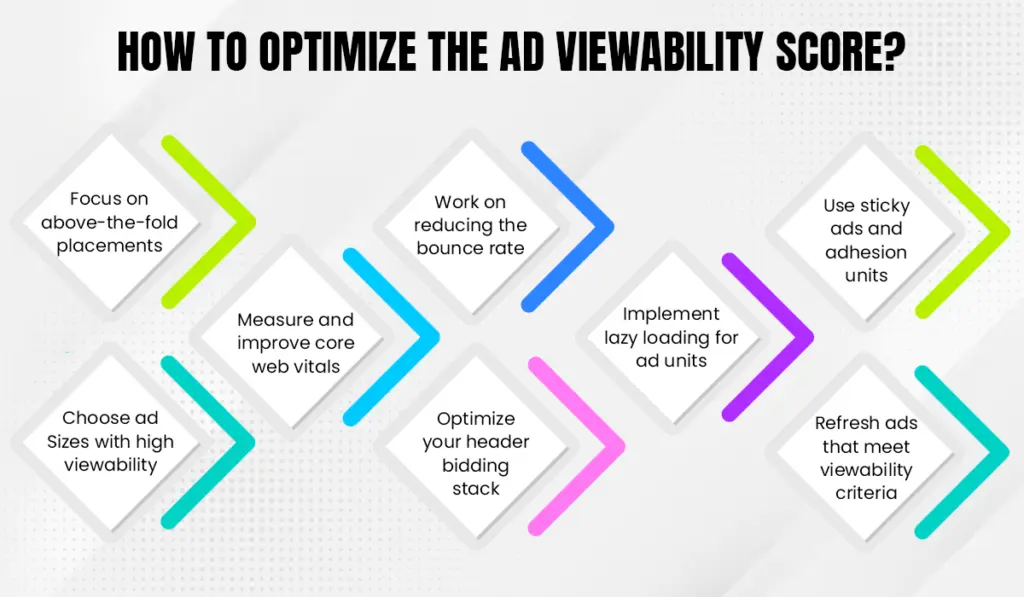
Focus on above-the-fold placements (excluding top-of-the-page placements)
Prioritize ad placements that are immediately visible when a user lands on a page. These placements are more likely to capture user attention and improve viewability.
Choose ad Sizes with high viewability
Certain ad sizes tend to perform better in terms of viewability. Select ad sizes that are more likely to be seen by users, thus improving viewability metrics.
Measure and improve core web vitals
Core Web Vitals, such as page load speed and interactivity, impact the user experience and ad viewability. By optimizing these metrics, you can enhance user engagement and improve ad viewability.
Work on reducing the bounce rate
High bounce rates indicate that users quickly leave your site, reducing the opportunity for ad impressions. Improving content relevance and user experience can lower bounce rates and increase ad viewability.
Optimize your header bidding stack
Header bidding allows publishers to offer ad inventory to multiple demand sources simultaneously, increasing competition and potentially improving viewability.
Implement lazy loading for ad units
Lazy loading delays the loading of ad units until they come into the user’s view, improving viewability by ensuring ads are only loaded when they have the potential to be seen.
Use sticky ads and adhesion units (in moderation)
Sticky ads and adhesion units remain fixed on the screen as users scroll, increasing the likelihood of ad visibility. However, using these formats sparingly is essential for a better user experience.
Refresh ads that meet viewability criteria
Refreshing ads that have been viewed by users can help maintain viewability metrics. However, it’s important to refresh ads responsibly to avoid annoying users and violating ad policies.
Conclusion
In conclusion, maximizing eCPM and optimizing ad revenue requires many factors, such as understanding key metrics, implementing effective strategies, and continuously refining tactics based on performance insights. By focusing on factors such as ad placement, ad formats, traffic sources, and viewability, publishers can enhance their revenue potential and deliver value to both advertisers and users.
FAQs
Q: How do I increase eCPM in Admob?
A: You can increase your eCPM earnings on AdMob by allowing all ad types to display. Conversely, restricting ad types may result in reduced revenue opportunities.
Q: What is India’s average eCPM?
A: The average eCPM in India varies between 0.50 USD and 2.00 USD. It depends on the type of ad format, such as native ads, banner ads, rewarded ads, and interstitial ads.
Q: Which country has a high eCPM?
A: Norway has the highest eCPM in the world, which is 43 USD.
Q: What is the eCPM formula?
A: eCPM = (Total Earnings ÷ Total Impressions) x 1,000
Q: What is a good eCPM?
A: The average eCPM is around $2 to $10. It is based on the location of the ad audience.
Q: What is the eCPM floor?
A: The eCPM floor is the minimum eCPM set for your ad units. This means that AdMob will serve ads that meet or exceed this set minimum value.




